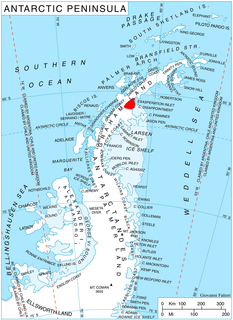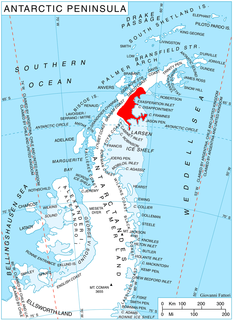The Geologists Range is a mountain range about 55 km (34 mi) long, standing between the heads of Lucy and Nimrod Glaciers in Antarctica. Seen by the northern party of the New Zealand Geological Survey Antarctic Expedition (NZGSAE) (1961–62) and named to commemorate the work of geologists in Antarctic exploration.

The Executive Committee Range is a mountain range consisting of five major volcanoes, which trends north-south for 80 km (50 mi) along the 126th meridian west, in Marie Byrd Land, Antarctica.

The Scott Mountains are a large number of isolated peaks lying south of Amundsen Bay in Enderby Land of East Antarctica, Antarctica. Discovered on 13 January 1930 by the British Australian New Zealand Antarctic Research Expedition (BANZARE) under Sir Douglas Mawson. He named the feature Scott Range after Captain Robert Falcon Scott, Royal Navy. The term mountains is considered more appropriate because of the isolation of its individual features.

Useful Island is an island 3.2 km west of Rongé Island, with a string of rocks between, lying in Gerlache Strait off the west coast of Graham Land. It was discovered by the Belgian Antarctic Expedition, 1897–99, under Adrien de Gerlache. The name appears on a chart based upon a 1927 survey by Discovery Investigations personnel on the RRS Discovery.

El-Sayed Glacier is a glacier about 15 nautical miles long which drains the northeast slopes of Zuncich Hill in Marie Byrd Land. It flows northeast to enter Land Glacier at the south side of Mount Shirley. It was mapped by the United States Geological Survey from surveys and U.S. Navy air photos, 1959–65, and was named by the Advisory Committee on Antarctic Names for Sayed Z. El-Sayed, a United States Antarctic Research Program oceanographer on the International Weddell Sea Oceanographic Expeditions, 1967–68 and 1969–70.

Ambergris Glacier is a glacier flowing south-southeast from Mount Sara Teodora between Chintulov Ridge and Valkosel Ridge to join Flask Glacier just west of Fluke Ridge in Aristotle Mountains on the east coast of Graham Land, Antarctica. One of several names in the area that reflect a whaling theme, it was named in 1987 by the United Kingdom Antarctic Place-Names Committee from the substance secreted by the sperm whale and used in perfumery.

Bigo Bay is a bay 8 nautical miles (15 km) long and 6 nautical miles (11 km) wide, indenting the west coast of Graham Land between Cape Garcia and Magnier Peninsula surmounted by the Magnier Peaks and Lisiya Ridge.

Bulkington Pass is a pass on the south side of Flask Glacier and west of Bildad Peak in Voden Heights on the east side of Graham Land. The pass trends northeast–southwest for 4 nautical miles (7 km) and provides a route from the ice piedmont north of Adit Nunatak to Flask Glacier. The toponym is one in a group applied by the UK Antarctic Place-Names Committee that reflects a whaling theme, Bulkington being a crewman on the vessel Pequod in Herman Melville's Moby Dick.
Cappellari Glacier is a glacier 11 nautical miles (20 km) long in the Hays Mountains, flowing west from the northwest shoulder of Mount Vaughan to enter Amundsen Glacier just north of Mount Dort. It was first roughly mapped by the Byrd Antarctic Expedition, 1928–30, and remapped by the United States Geological Survey from ground surveys and from U.S. Navy air photos, 1960–64. It was named by the Advisory Committee on Antarctic Names for Lewis K. Cappellari who made ionospheric studies at McMurdo Station in 1965.
Mount Cartledge is a mountain just east of Mount Albion in the Athos Range, Prince Charles Mountains. It was plotted from Australian National Antarctic Research Expeditions air photos of 1965, and named by the Antarctic Names Committee of Australia for W.J. Cartledge, plumber at Wilkes Station in 1962, and carpenter at Mawson Station in 1966.
Mount Cheops is a mountain, over 610 metres (2,000 ft) high, standing 8 nautical miles (15 km) south-southeast of Cape Garcia on the west coast of Graham Land. It was mapped by the Falkland Islands Dependencies Survey from photos taken by Hunting Aerosurveys Ltd in 1956-57, and named by the UK Antarctic Place-Names Committee after the Great Pyramid of Giza because of its distinctive shape.
Stout Spur is a knife-like rock spur descending from the north edge of Mackin Table, 3 nautical miles (6 km) east of Mount Campleman, in the Patuxent Range, Pensacola Mountains. Mapped by United States Geological Survey (USGS) from surveys and U.S. Navy air photos, 1956-66. Named by Advisory Committee on Antarctic Names (US-ACAN) for Dennis K. Stout, radioman at Palmer Station, winter 1967.
Moffett Glacier is a tributary glacier, 13 nautical miles (24 km) long, flowing east from Rawson Plateau to enter Amundsen Glacier just south of Mount Benjamin, in the Queen Maud Mountains of Antarctica. it was discovered by Rear Admiral Richard E. Byrd on the South Pole flight of November 28–29, 1929, and named by him for Rear Admiral William A. Moffett, U.S. Navy, first Chief of the Bureau of Aeronautics, Department of the Navy.
Mount Galla is a snow-capped mountain, 2,520 metres (8,270 ft) high, which rises above the Usas Escarpment, 31 nautical miles (57 km) east of Mount Petras, in Marie Byrd Land, Antarctica. It was mapped by the United States Geological Survey from surveys and U.S. Navy air photos, 1959–65, and was named by the Advisory Committee on Antarctic Names for Lieutenant Edward J. Galla, U.S. Navy, who was medical doctor and leader of support personnel at Byrd Station, 1959.
Mount Lira is a mountain located 5 nautical miles (9 km) east of the Condon Hills, in Enderby Land, Antarctica. The geology of this feature was investigated by the Soviet Antarctic Expedition of 1961–62, which called it "Gora Lira", probably because of its shape.
Mount McMahon is a mountain about 5 nautical miles (9 km) west of Mount Bewsher in the Prince Charles Mountains of Antarctica. It was plotted from Australian National Antarctic Research Expeditions air photos, and was named for R. McMahon, officer in charge at Mawson Station in 1963.

Mount Malone is a big mountain, 2,460 metres (8,070 ft) high, located 8 nautical miles (15 km) east of Mount Barden in the northern part of the Sentinel Range of the Ellsworth Mountains in Antarctica. It is the summit of Sostra Heights, surmounting Sabazios Glacier to the west and Anchialus Glacier to the northeast.

Hotine Glacier is a glacier 10 nautical miles (19 km) long which is divided at its mouth by Mount Cloos, flowing west into both Deloncle Bay and Girard Bay on Kiev Peninsula, on the west coast of Graham Land, Antarctica. It was first charted by the Belgian Antarctic Expedition under Gerlache, 1897–99, and was named by the UK Antarctic Place-Names Committee in 1959 for Brigadier Martin Hotine, Director of Overseas Surveys.
Linder Peak is a somewhat lower but very imposing peak standing immediately south of Mount Dolence in the Heritage Range, Ellsworth Mountains, Antarctica. It was mapped by the United States Geological Survey from surveys and U.S. Navy air photos from 1961–66, and was named by the Advisory Committee on Antarctic Names for Harold W. Linder, a geophysicist with the United States Antarctic Research Program Ross Ice Shelf party of 1961–62.











